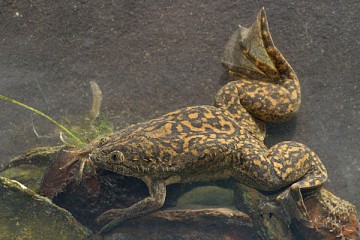
The African clawed frog (Xenopus laevis) is immune to the chytrid fungus (Batrachochytrium dendrobatidis), as this fungus is native to the habitat of the frog in Africa. This frog was distributed around the globe by humanity as they were used for pregnancy tests. It is very likely that together with the frogs the fungus was distributed as well, causing the extinction of many amphibian species so far. Although presence of the funfus is already proven in Hungary, but so far we have no knowledge of causing mass mortality in our country, as well as no resident African clawed frog population. (photo: Jan van der Voort)
Under this category we expect to receive observation data of such species that are non-native or their identification is unsure.
In such cases the attachement of a verification picture is very important!
Distibution map by our National Herpetological Mapping Program: